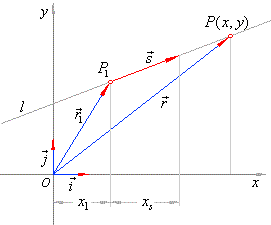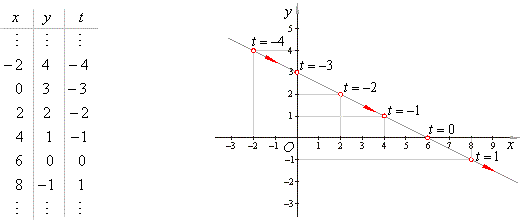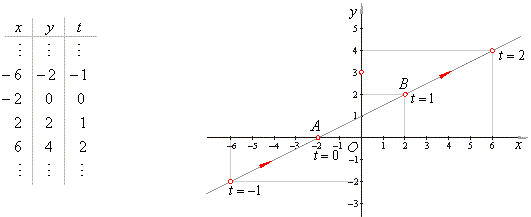|
|
|
|
Parametric Equations |
 Parametric
equations definition
Parametric
equations definition |
 The parametric equations of a line
The parametric equations of a line
|
|
The
parametric equations of a line passing through two points |
|
The direction of
motion of a parametric curve |
|
Evaluation
of parametric equations for given values of the parameter |
|
Sketching parametric
curve |
|
Eliminating the
parameter from parametric equations |
|
Parametric
and rectangular forms of equations
conversions |
 Use
of parametric equations, example
Use
of parametric equations, example |
|
|
|
|
|
|
| Parametric
equations definition |
| When
Cartesian coordinates of a curve or a surface are represented as
functions of the same variable (usually written t),
they are
called the parametric equations. |
| Thus,
parametric equations in the xy-plane |
| x
= x (t)
and y
= y (t) |
| denote
the x
and y
coordinate of the graph of a curve in the plane. |
|
| The parametric equations of a line
|
| If
in a coordinate plane a line is defined by the point P1(x1,
y1) and the
direction vector s
then, the position or (radius)
vector r
of any point P (x,
y) of the line |
| r
= r1 + t · s,
-
oo
< t < + oo
and
where, r1
= x1i + y1 j
and s
= xsi + ys j, |
| represents the vector equation of the line. |
| Therefore,
any point of the line can be reached by the |
| radius vector |
| r
= xi + y j
= (x1 + xst) i
+ (y1 + yst) j |
| since the scalar quantity t
(called the
parameter) can take |
| any real value from -
oo
to + oo. |
| By
writing the scalar components of the above vector |
| equation obtained is |
| x
= x1 + xs · t |
| y
= y1 + ys · t |
|
|
| the parametric
equations of the line. |
|
 |
|
| To
convert the parametric equations into the Cartesian coordinates solve
given equations for t.
So |
 |
| by
equating |
 |
|
| Therefore,
the parametric equations of a line passing through
two points P1(x1,
y1) and P2(x2,
y2) |
| x
= x1 + (x2 -
x1) t |
| y
= y1 + (y2 -
y1) t |
|
|
|
| Parametric
curves have a direction of motion |
| When
plotting
the points of a parametric curve by increasing t, the
graph of the function is traced
out in the direction of motion. |
|
| Example: Write
the parametric equations of the line y
= (-1/2)x
+ 3 and sketch its graph. |
| Solution: Since |
 |
|
|
| Let
take the x-intercept as
the given point P1, so |
| for
y
= 0 =>
0 = (-1/2)x
+ 3, x
= 6 therefore,
P1(6,
0). |
| Substitute
the values, x1
= 6, y1
= 0, xs
= 2,
and ys
= -1
into the parametric equations of a line |
| x
= x1 + xs · t,
x
= 6 + 2t |
|
y
= y1 + ys · t,
y = -t |
 |
|
The direction of motion (denoted by red arrows) is given by increasing t. |
|
| Example: Write
the parametric equations of the line through points, A(-2,
0) and B(2,
2) and sketch the graph. |
| Solution:
Plug the coordinates x1
= -2,
y1
= 0, x2
= 2, and y2
= 2
into the parametric equations of a line |
|
x
= x1 + (x2 -
x1) t,
x
= -2
+ (2 + 2) t
= -2 +
4t,
x
= -2 +
4t, |
|
y
= y1 + (y2 -
y1) t,
y = 0
+ (2 -
0) t
= 2t,
y
= 2t. |
| To
convert the parametric equations into the Cartesian coordinates solve |
| x
= -2 +
4t
for t
and plug into y
= 2t |
|
therefore, |
 |
|
|
 |
|
| Use
of parametric equations, example |
| Intersection point of a line and a plane
in three dimensional space
|
| The point of intersection is a common point of a line and a plane. Therefore, coordinates of intersection must
satisfy both equations, of the line l
and the plane P |
| |
 |
and |
 |
|
|
|
where, (x0,
y0,
z0) is a
given point of the line and s =
ai + bj + ck
is direction vector of the line, and |
| N =
Ai + Bj + Ck
is the normal vector of the given plane. |
| Let
transform equation of the line into the parametric form |
 |
| Then,
the parametric equation of a line, |
| x =
x0 + at,
y = y0
+ bt and
z
= z0 + ct |
| represents coordinates of any point of
the line expressed as the function of a variable parameter t
which makes
possible to determine any point of the line according to a given condition. |
| Therefore, by plugging these variable coordinates of a point of the line into
the given plane determine what value
must have the parameter t,
this point to be the common point of the line and the plane. |
|
| Example:
Given is a line |
 |
and a plane
4x -
13y + 23z -
45 = 0, find the
|
|
| intersection
point of the line and the plane. |
| Solution: Transition from the symmetric to the parametric form
of the line
|
 |
| by plugging these variable coordinates
into the given plane we will find the value of the parameter t
such that these
coordinates represent common point of the line and the plane, thus |
| x =
-t +
4, y
= 4t -
3 and z
= 4t -
2 =>
4x -
13y + 23z -
45 = 0 |
| which
gives, 4 · (-t +
4) - 13 · (4t -
3) + 23 · (4t -
2) -
45 = 0 => t = 1. |
| Thus,
for t = 1
the point belongs to the line and the plane, so |
| x =
-t +
4 = -
1+ 4 = 3, y =
4t -
3 = 4 · 1 -
3 = 1 and z =
4t -
2 = 4 · 1 -
2 = 2. |
| Therefore, the intersection point
A(3,
1,
2) is the point which
belong to both, the line and the plane, prove. |
|
|
|
|
|
|
|
|
|
|
|
|
|
|
|
|
| Pre-calculus
contents C |
|
|
 |
|
| Copyright
© 2004 - 2020, Nabla Ltd. All rights reserved. |